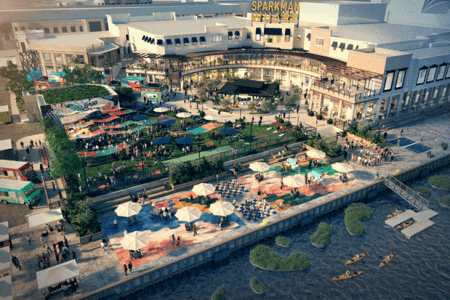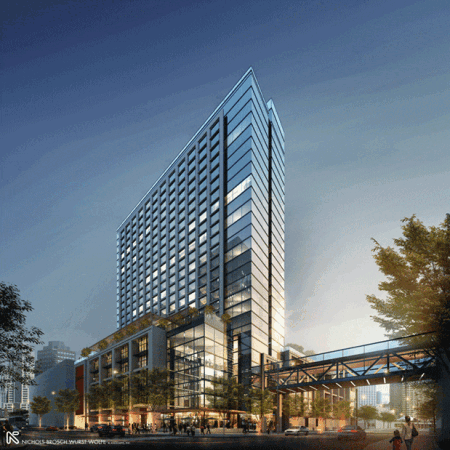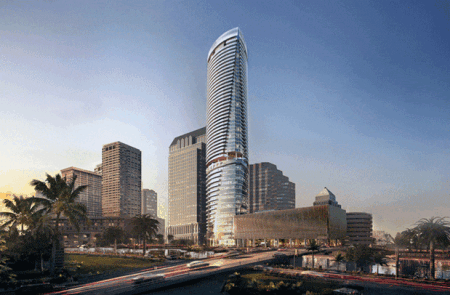For decades, Tampa, Florida, was a city that got no respect. One magazine called it “a hot urban mess.” Studies of U.S. cities routinely listed it near the bottom for walkability and commuting. A 2016 report by Smart Growth America ranked Tampa as the seventh most dangerous metropolitan region in America for pedestrians.
On a fundamental level, something was wrong with the city, says Bob Buckhorn, mayor of Tampa. “We were a donor city to other cities,” he says. “Talent was leaving to Charlotte, San Diego, Austin—and they weren’t coming back.”
In recent years, though, something changed in Tampa. It has joined the ranks of reenergized U.S. cities. Large-scale, mixed-use developments are springing up throughout the city, with more than $13 billion in nonresidential and multifamily projects expected in the pipeline by 2022, according to Dodge Data & Analytics forecasts. In the 2015 edition of the Emerging Trends in Real Estate® report published by ULI and PwC, Tampa/St. Petersburg ranked 35th for overall real estate prospects; in the 2018 survey, it rose to 19th overall and seventh for development. No longer a “donor city,” Tampa is seeing its population increasing by 50,000 people a year.
“Momentum is what is so palpable,” says ULI Tampa Bay chair Barry Karpay, who grew up locally and works as vice president of land acquisition for Lennar Homes in the Tampa Bay area.
By all accounts, the regeneration of Tampa is no accident or twist of fate. The city took specific steps to change the course of events, to compete with the cities stealing talent and development dollars. The city’s experiences show how a focus on the waterfront, green spaces, and smart development can change the future of a downtown and the surrounding neighborhoods. In many ways, Tampa provides a roadmap for how to reinvent and spark a city’s fortunes.

The $3 billion Water Street Tampa project will include 18 towers, 3,500 residential units, two hotels, 1 million square feet (93,000 sq m) of retail space, more than 2 million square feet (186,000 sq m) of offices, a cultural center, and 13 acres (5 ha) of green and public spaces. (Courtesy Strategic Property Partners)
Water Street Tampa
Any discussion of the new Tampa starts with the Water Street District, the $3 billion development transforming the downtown. Created by a partnership of Tampa Bay Lightning hockey team owner Jeffrey Vinik and Microsoft founder Bill Gates’s Cascade Investment, the 50-acre (20 ha) project will include 18 towers, 3,500 residential units, two hotels, 1 million square feet (93,000 sq m) of retail space, over 2 million square feet (186,000 sq m) of office space, a cultural center, and 13 acres (5 ha) of green and public spaces.
The development group is the stuff of dreams for most cities—members have deep pockets, a clear vision, and a commitment to technology and sustainability. “With everything we are doing, we have a long-term focus,” says James Nozar, chief executive officer of Strategic Property Partners (SPP), the company formed to manage the development. “We have no plans to sell real estate.”
Construction is underway on ten towers in the first phase, including a JW Marriott hotel, apartments, an office tower, and new facilities for the University of South Florida’s Morsani College of Medicine and Heart Institute. The project has also started reconfiguring the area’s road system, including new bike paths. The city and county are putting $100 million into infrastructure and new streets, funded through tax increment financing.
“That was a no-brainer for us,” Buckhorn says.
But local experts say the change in Tampa started before the Water Street Tampa project, with several key moves that helped make the downtown a more desirable place to live. City investments in a performing-arts center, a convention center, a historic district, a 250,000-square-foot (23,000 sq m) aquarium, and an arena for Vinik’s hockey team all contributed to changing the direction of downtown.
But the biggest step, many observers agree, was the completion of the 2.6-mile (4 km) Riverwalk trail along the Hillsborough River, which had been discussed and developed in bits and pieces over 40 years. The last major section was finished in 2015, with the help of a $10.9 million federal Transportation Investment Generating Economic Recovery (TIGER) grant.
“That singular event [the completion of the river trail] changed the course of downtown Tampa,” Buckhorn says. “The river became the focus and center point for everything in the urban core.”
The Riverwalk was the catalyst for several changes along the waterfront, which had been primarily an industrial zone. Restaurants opened, drawing people to the neighborhoods at night. Several new parks were created and infill projects started activating different areas, such as the redevelopment of a former trolley barn into Armature Works, a 73,000-square-foot (6,800 sq m) mixed-use project with shared workspace, event space, and a food hall, the Heights Public Market.
The trolley barn had been a “big hulking building that sat empty for many years,” says Robert MacLeod, director of the school of architecture and community design at University of South Florida.
Tampa was “kind of a typical, fragmented, postwar multicentric city,” says MacLeod, who moved to the city in 2009. There was “not a clear network of green space . . . and the waterfront was not taken advantage of,” he says. “The vision of downtown wasn’t sorted out for a long time.”
As the city turned its focus to the waterfront, it also changed its attitude toward developers, Buckhorn says. The city has completely reconfigured its permitting process, including an emphasis on more personalized service, and relocated related departments closer together. “We took it apart and put it back together,” he says. The goal was to avoid conflicting advice and make it easier for developers to connect with the right people, the mayor says.
Enlivening Downtown
Making the city more livable, with more green space and increased walkability, was a key goal for the city’s early investments. Tampa “was a late bloomer in the [residential] recovery,” says Kim Kennedy, manager of forecasting for Dodge Data & Analytics, based in Bedford, Massachusetts. But it is catching up. More than $5.3 billion will be spent on residential construction starts alone in 2018, Dodge predicts, almost double the residential volume in 2014.
Downtown was a “ghost town after 6:00,” says developer Larry Feldman, chairman and chief executive of Feldman Equities, a Tampa-based developer and building owner. His company is building Riverwalk Place, which, at 50 stories, will be the tallest tower on the west coast of Florida. The $350 million tower, designed by Gensler, will include 33 levels of condominiums and 10 floors of office space.
“Tampa is late to the game of mixing uses,” Feldman says.
Prices for condos in Riverwalk Place range from $600,000 to $2 million, which will test the appetite for downtown homes. “Wealth and money have always been around here,” Feldman says. “But they never thought about living downtown.”
In recent years, most of the residential development has focused on multifamily, which has been booming.
Apartment specialist Bainbridge Companies built its first project in the Tampa Bay area four years ago and now has four projects under construction and five more in the pipeline. Rents “have been significantly higher than expected,” and are steadily increasing by more than 5 to 7 percent a year, says Bob Thollander, vice president of development for Florida for the Bainbridge Companies. Current rents average about $1.45 per rentable square foot ($15.60 per sq m) to $1.65 per square foot ($17.76 per sq m) in outlying areas and $2 per square foot ($21.53 per sq m) to $2.35 per square foot ($25.30 per sq m) in downtown Tampa, which is higher than rents seen in many cities in Florida, Thollander says.
In 2017, Bainbridge paid $13.2 million for a 12-acre (5 ha) parcel in the Westshore Marina District, located on the south Tampa waterfront, where Bainbridge is building a project with 351 apartments. After efforts to develop the Westshore district stalled in the wake of the 2008 recession, BTI Partners, based in Fort Lauderdale, acquired a total of 52 acres (21 ha) and it has been selling off parcels to developers like Related, WCI Communities, and Bainbridge.
The Westshore district is “red hot,” says Thollander.
Not far from Westshore, the Bromley Companies, based in New York City, is developing Midtown Tampa, a $500 million, 22-acre (9 ha) mixed-use project about four miles (6.4 km) from downtown. Midtown Tampa will offer 1.8 million square feet (167,000 sq m) of commercial space, including a central promenade with shops and restaurants, 750,000 square feet (69,700 sq m) of office space, and a hotel, in addition to 400 apartments and four acres (1.6 ha) of public space.
Bromley has owned a building on the site since the mid-1990s, but never was able to expand. In 2003, the company developed a plan to build three office towers on the land, but the project was never built. The market “had not grown up yet,” says Bromley chairman William Haines.
Today, “Tampa is the only market that attracts me in Florida,” Haines says. Unlike other built-out markets, Tampa “has some ‘up’ to it,” he says. “It’s a good market and it’s going to get better.”
Before the recent development, there had not been a new Class A office tower erected in Tampa in decades. But the market has been slowly recovering, with the office vacancy rate at 12 percent, down from 14.6 percent in 2015, according to data from consultancy JLL. “There are a multitude of factors driving demand,” says Ryan Vaught, senior vice president for JLL in Tampa.
Construction costs have shot up 20 to 25 percent in the last 18 months, due to labor shortages and rising material prices, Vaught says. But “fundamentals remain strong across the region,” which should continue to drive office asking rates and absorption higher as the new round of developments are completed, JLL concludes in a recent report.
Tampa is attracting higher-end tenants, primarily from the health industry, including new offices for Amgen, Johnson & Johnson, and Bristol-Myers Squibb. Almost 145,000 jobs were created in the area from 2013 to 2017, according to the U.S. Bureau of Labor Statistics.
Resilience Challenges
All the buzz about new development can blur the memory of a year ago, when Tampa Bay was facing the advance of Hurricane Irma. The storm ultimately skirted the city, however, doing far less damage than originally feared.
“I don’t think there has been new interest in resilience,” but there is a “totally different perspective than a year ago,” says Leigh Fletcher, a local land use attorney who participated in a ULI Resilience Task Force on Tampa in 2016, before Irma.
A 2015 report by Karen Clark & Company, a Boston-based risk-analysis firm, found that Tampa/St. Petersburg is the U.S. metropolitan area most vulnerable to flooding damage. Many of the new projects, including Water Street Tampa and Riverwalk Place, are addressing that risk by placing critical mechanical systems and public spaces higher in buildings, above projected flood levels.
But the city has done little to deal with potential storm surge since Hurricane Irma, says Kent Bailey, chair of Sierra Club Tampa. Local governments are “not taking the actions a community should be taking that is facing the threat level we do,” he says. “It makes no sense that we haven’t really significantly changed the building code to reflect the real threat to the community.”
The region’s efforts to update the city’s much-derided transportation network also have not kept up with the city’s growth, many observers agree. In recent years, two initiatives proposing to develop light rail and expand public transit networks have failed to win support from voters.
“We have struggled on the transportation front,” Buckhorn says. “If anything, that would be the Achilles’ heel. We have to resolve that.”
In April, the city killed a hotly debated plan to use a “road diet” to redesign a stretch of Bay to Bay Boulevard, a key south Tampa artery. The plan would have added bike lanes and reduced the number of lanes on the road, following an engineering study that concluded that the changes would make the road safer. But the city decided that the changes would cause a “major disruption of a very busy thoroughfare,” drawing protests from local bike and walkability advocates.
But there has been progress in extending hiking and biking trails, primarily through the new real estate developments. “The private sector is leading the way,” says Christine Acosta, executive director of the nonprofit advocacy group Walk Bike Tampa. “The city is still lagging.”
Water Street has made wellness and walkability centerpieces of the design, as it aims to become the first community to earn WELL certification from the International WELL Building Institute. The project will include sidewalks measuring 45 feet (13.7 m) wide, 650 new trees, green terraces, and a centralized cooling system that will allow for landscaped roofs throughout the district.
“Water Street is the poster child for all that is good in urban planning,” Acosta says.
Water Street is also focusing on integrating technology into the project, with fiber built into the streets, 5G connectivity, routes for autonomous vehicles, and “smart” parking garages that will be designed with the potential for repurposing later if autonomous vehicles reduce the need for parking.
“We really think we can be the first true smart district in the country,” Nozar says.
Any talk of a real estate boom in Florida inevitably gets around to the potential for a bust, given the state’s rollercoaster history. But observers say that Tampa, in many ways, is simply earlier in this cycle than other cities.
“We’re in the second or third inning” of the cycle, Feldman says.
Several new catalysts loom on the horizon, including the potential new downtown stadium for the Tampa Bay Rays, the Major League Baseball team. The team has proposed a $900 million domed stadium in the Ybor City area, northeast of downtown. “If the Rays come downtown, no matter where it goes, there will be ancillary benefits,” says JLL’s Vaught.
More than anything, the city has successfully changed its “economic DNA,” Buckhorn says. The city is “part of conversations that we have never been in before,” he says, adding, “We don’t worry about losing kids to Charlotte anymore.”









